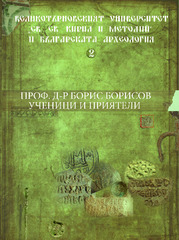Приказ основних података о документу
Керамика съц слюдесто покритие: нов поглед към находките от централните Балкан
| dc.creator | Бикич, Весна | |
| dc.date.accessioned | 2023-11-26T17:32:35Z | |
| dc.date.available | 2023-11-26T17:32:35Z | |
| dc.date.issued | 2016 | |
| dc.identifier.isbn | 978-619-205-041-2 | |
| dc.identifier.uri | http://rai.ai.ac.rs/handle/123456789/1025 | |
| dc.description.abstract | Vessels with gold and silver slip make a particularly interesting group of Mediaeval Balkan pottery, not only for their characteristic features but for inspiring different questions on their origin and production in the eleventh and twelfth centuries. In addition to the finds from Bulgaria, this pottery is well-documented in the Central Balkans – better than it could be deduced from the distribution map only. The finds from both major (Belgrade, Braničevo, Niš) and minor settlements (Gamzigrad, Ribnica, Brza Palanka, Popovica), that is from fortresses and villages alike, testify to this group's presence in pottery repertoire of that time. Although much more numerous, finds from Bulgaria show a similar distribution pattern. Among the vessels with micaceous slip, jugs constitute by far the largest group; other forms appear only sporadically (Fig. 1). From what was published one can ascertain two different find categories: fine ware with relatively thin walls and red firing colour (Fig. 1/1-4) and coarse ware with a sandy texture and mica and quartz temper, brown-grey in colour (Fig. 1/5-15). Silver and gold slip may vary in thickness, from almost transparent to intensive. Two decorative schemes can be observed in this pottery, brush-painted in red pigment – one consisting of spirals and garlands (Fig. 1/1-4), and the other of crossed lines and coloured fields (Fig. 1/5-12, 15). It thus appears that decorative concepts were intimately connected with distinct quality-groups. Furthermore, some regularities can be observed in both the chronology and the distribution pattern of this pottery. During the first phase, roughly dated to the second half of the eleventh and the beginning of the twelfth century, pottery with micaceous slip represented one of the two ’foreign’ groups of tableware (the other comprised green-glazed jugs). In the course of the second phase, around the middle of the twelfth century, these two groups were included in the standard pottery repertoire, together with sgraffito and champlevé plates and red burnished amphora-like jugs. Commonly found in pottery contexts, the slip-ware was obviously affordable to different social groups. Its distribution reveals good connections between the military camps and settlements and speaks of an active trade throughout the eleventh and twelfth centuries. From all the analyses, it appears beyond any doubt that pottery with gold and silver slip was produced in Bulgaria. Judging by technological and stylistic features, it certainly came from several workshops, likely concentrated in one region – Thrace in southern Bulgaria. As the production was most intense in the eleventh and twelfth centuries, it can be most easily understood within the framework of the then-established Byzantine authority over the region. The progress in pottery production, not only in technological sense but in standardisation too, can be studied across the Balkans; it is also obvious if one observes ware with micaceous slip. To localise the workshops solely on the basis of archaeological evidence is not a trouble-free task; neither is to pass the judgement on production organisation. Large-scale petrographic and physical-chemical analyses could be of great help, especially if taking into account the finds from different regions and possible sources of raw material, i.e. clay. Pottery with Micaceous Slip testifies to a developed interregional exchange. Its share in overall pottery production was significant, which is particularly striking in Byzantine military and Byzantinised settlement contexts. In that respect, one should underscore its formal and, to some extent, decorative similarities with contemporaneous and older red burnished pottery of Bulgarian provenance. Both groups’ distribution areas share their western borders, which thus may be seen as delineating the interest zone of this cultural (if not political) milieu in the Central Balkans. | sr |
| dc.language.iso | other | sr |
| dc.publisher | Велико Търново : Издателство "ИВИС" | sr |
| dc.relation | info:eu-repo/grantAgreement/MESTD/Basic Research (BR or ON)/177021/RS// | sr |
| dc.rights | openAccess | sr |
| dc.source | Studii in honorem professoris Borisi Borisov | sr |
| dc.subject | Central Balkans | sr |
| dc.subject | Bulgarian workshops | sr |
| dc.subject | Middle Byzantine period | sr |
| dc.subject | technology | sr |
| dc.subject | red burnished jugs | sr |
| dc.subject | interregional exchange | sr |
| dc.title | Керамика съц слюдесто покритие: нов поглед към находките от централните Балкан | sr |
| dc.type | bookPart | sr |
| dc.rights.license | ARR | sr |
| dc.citation.epage | 569 | |
| dc.citation.spage | 563 | |
| dc.identifier.fulltext | http://rai.ai.ac.rs/bitstream/id/2540/bitstream_2540.pdf | |
| dc.identifier.rcub | https://hdl.handle.net/21.15107/rcub_rai_1025 | |
| dc.type.version | publishedVersion | sr |


